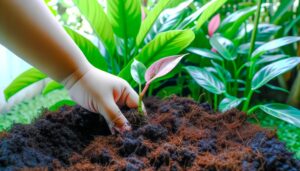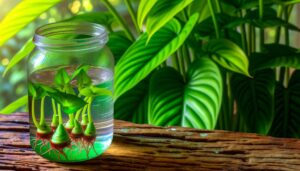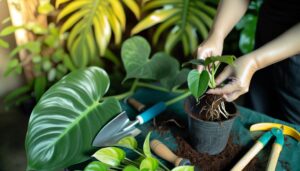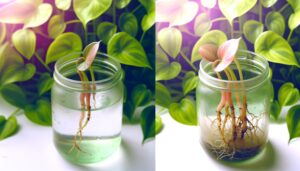Can You Propagate Philodendron Without a Node? Explained!
Propagation of philodendron without a node is not feasible. Nodes are essential as they contain meristematic tissue, necessary for root and shoot formation.
In their absence, cuttings are unlikely to develop the required root system for successful growth. Nodes serve as growth points facilitating nutrient transport and organ generation.
Consequently, attempting propagation with leaves alone or stem segments lacking nodes results in minimal success rates. Propagation methods like stem cuttings, which utilize nodes, guarantee the transfer of genetic characteristics and achieve higher success rates.
Explore more to understand the complexities and best practices in philodendron propagation.
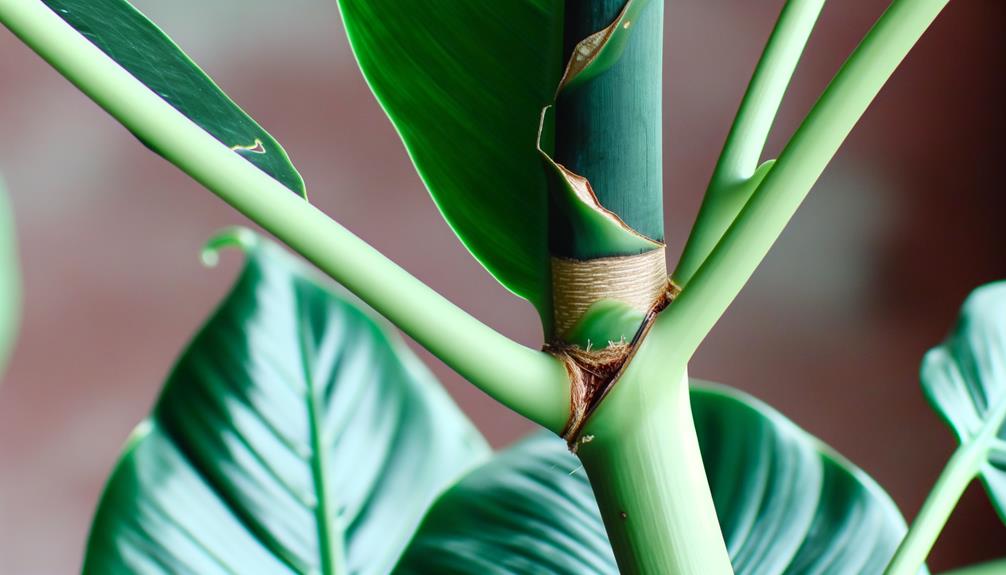
Key Takeaways
- Propagating philodendron without a node is generally unsuccessful due to the lack of meristematic tissue.
- Nodes are essential for root and shoot development in philodendron propagation.
- Absence of nodes in cuttings significantly reduces their viability for propagation.
- Nodes contain crucial cellular structures necessary for nutrient transport and growth initiation.
- Successful philodendron propagation requires cuttings with at least one node.
Understanding Philodendron Anatomy
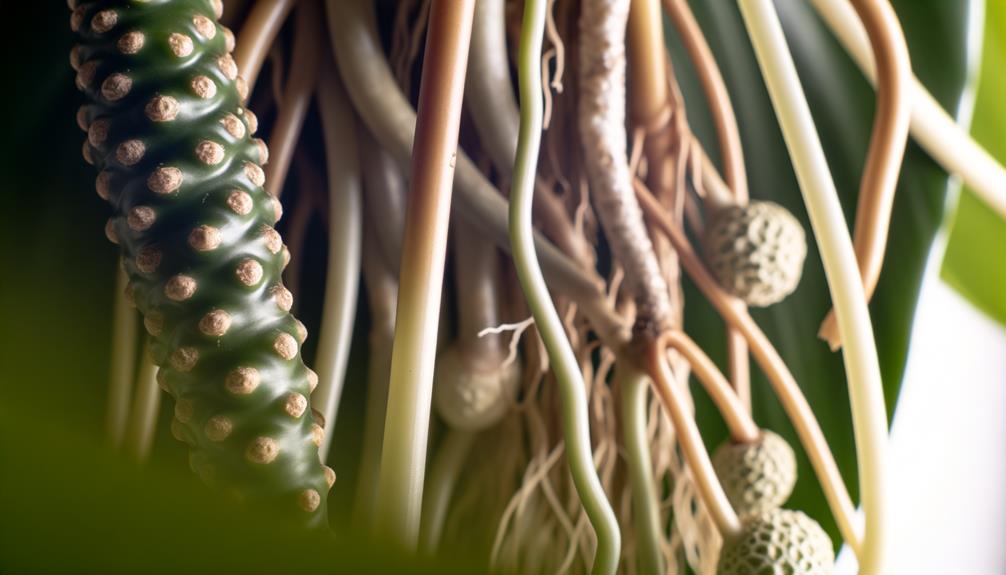
The anatomy of a philodendron is comprised of several key structures, including the node, internode, leaf, and root system, each playing an essential role in the plant’s overall growth and propagation.
The internode is the stem segment between two nodes, providing structural support and facilitating the transport of nutrients and water.
Leaves, attached at nodes, are responsible for photosynthesis, converting light energy into chemical energy.
The root system, which anchors the plant, absorbs water and essential nutrients from the soil.
Each of these components works in synergy, ensuring the philodendron’s pivotal physiological processes are maintained.
Understanding these structures is critical for effective propagation and overall plant care, offering insight into the plant’s complex biological mechanisms.
What Is a Node?
A node is a critical anatomical feature located on the stem of a philodendron, serving as the primary site for new growth. This structure functions as a growth point where leaves, roots, and sometimes flowers originate.
Identifying nodes is essential for effective propagation and can be achieved by noting the slightly thicker segment of the stem often accompanied by small bumps or protrusions.
Location on Stem
In botany, a node refers to the specific location on a plant stem where leaves, branches, or aerial roots originate, serving as an important point for growth and propagation. The nodes are identifiable by slight enlargements or swells along the stem where these structures emerge.
In philodendrons, nodes are often visibly marked by small bumps or scars where leaves or roots were previously attached. These nodes contain meristematic tissue, which is essential for vegetative reproduction.
When considering propagation, recognizing the exact position of nodes on the stem is essential, as cutting below a node ensures that the new plant has the necessary cellular machinery to generate roots and new growth. Without a node, successful propagation is highly improbable.
Growth Point Function
Nodes serve as essential growth points on a plant stem, facilitating the development of leaves, branches, and roots through their meristematic tissue.
These regions are composed of undifferentiated cells that retain the capacity for continual division and differentiation, enabling the plant to generate new organs. The presence of nodes underscores a plant’s ability to adapt and proliferate, as they are vital for vegetative propagation.
Below is a table summarizing the functions and characteristics of nodes:
| Function | Description | Importance |
|---|---|---|
| Leaf Development | Initiates growth of new leaves | Essential for photosynthesis |
| Branch Formation | Generates new branches | Increases structural complexity |
| Root Initiation | Forms adventitious roots | Enhances nutrient uptake |
Understanding these roles is crucial in appreciating the significance of nodes in plant propagation.
Identifying Nodes Easily
Recognizing a node is fundamental to successful plant propagation, as it is the point on the stem where leaves, branches, and roots originate. Nodes are typically characterized by a slight swelling of the stem and the presence of leaf scars or petiole attachments.
In philodendrons, nodes can be identified by locating these distinct features along the stem. The internodal regions, or the spaces between nodes, lack these critical growth points and are generally smoother.
For effective propagation, make sure that each cutting contains at least one node, as this is essential for root development and new growth. Accurate identification of nodes enhances the likelihood of propagation success, as these are the sites of cellular differentiation and meristematic activity necessary for plant regeneration.
Importance of Nodes in Propagation

A node’s important role in propagation lies in its capacity to generate new roots and shoots, facilitating the growth of a new plant.
Technically, nodes are pivotal because they contain meristematic tissue, which is responsible for cell division and differentiation. This tissue enables the formation of root primordia and shoot apices, essential for the development of a complete, independent plant.
The absence of a node in a cutting significantly reduces its viability for propagation, as it lacks the necessary anatomical structures to initiate root and shoot development. Additionally, nodes serve as the foundation for adventitious root formation, a critical process in vegetative propagation.
Hence, the presence of nodes is essential for successful propagation efforts in philodendrons.
Common Propagation Methods
Utilizing stem cuttings and air layering are among the most prevalent methods for propagating philodendrons. Stem cuttings involve excising a segment of the stem that includes nodes, which are critical for root development. This segment is then placed in water or a suitable growing medium until new roots form.
Air layering, on the other hand, entails creating a wound on a healthy stem and wrapping it with moist sphagnum moss and plastic to encourage root formation while still attached to the parent plant. Both methods guarantee the new plant inherits the genetic characteristics of the parent.
These techniques are efficient and yield high success rates, making them favored by both horticulturists and enthusiasts alike.
Can Leaves Alone Root?
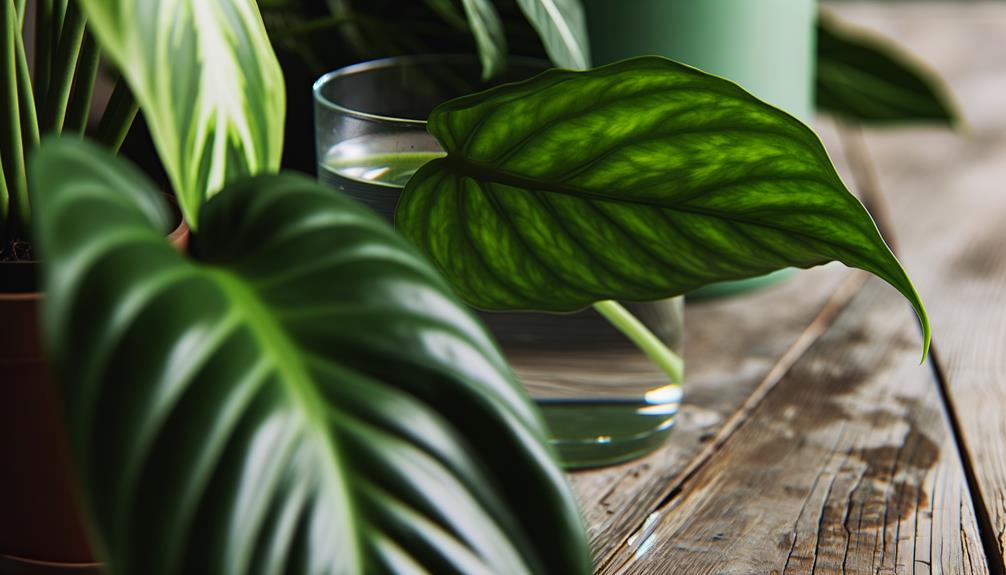
Propagation using only philodendron leaves presents significant challenges due to the absence of a node, which is essential for root initiation.
While rooting hormones may enhance the potential for root development, their effectiveness remains limited when nodes are not present.
Consequently, leaf-only propagation tends to result in lower success rates compared to traditional methods involving nodes.
Leaf-Only Propagation Challenges
Rooting philodendron leaves without a node presents significant challenges due to the absence of the necessary meristematic tissue required for root formation.
Without nodes, several critical elements for successful propagation are missing:
- Meristematic Cells: Essential for new growth, these cells are found in nodes and are absent in leaf-only cuttings.
- Adventitious Root Formation: Nodes contain the hormonal and cellular structures needed for roots to form spontaneously.
- Nutrient Storage and Transport: Nodes serve as a hub for distributing nutrients required for root development, a function leaves alone cannot perform.
Given these limitations, leaf-only propagation is highly unlikely. Such insights underscore the importance of including nodes in cuttings to guarantee successful philodendron propagation.
Rooting Hormones Effectiveness
The application of rooting hormones to leaf-only cuttings of philodendron has been explored to assess their potential in promoting root development despite the absence of nodes. Research indicates that auxin-based rooting hormones, such as Indole-3-butyric acid (IBA) and Naphthaleneacetic acid (NAA), can enhance adventitious root formation.
However, experimental results show limited success in philodendrons. The absence of nodes, which are critical for the initiation of root primordia, hampers rooting to a large extent. While rooting hormones may enhance cellular activity and encourage root formation in certain species, philodendrons typically require nodal segments for successful propagation.
Thus, despite the theoretical benefits of rooting hormones, their effectiveness on leaf-only cuttings of philodendron remains minimal. Further research is needed to explore alternative propagation strategies.
Role of Stem Cuttings
Stem cuttings serve as a crucial method in the propagation of philodendrons, particularly when aiming to cultivate plants without a node. This technique involves excising a section of the stem, which can be encouraged to root under ideal conditions.
The efficacy of stem cuttings hinges on several factors:
- Cutting Quality: Healthy, disease-free stems increase the likelihood of successful rooting.
- Environmental Conditions: Adequate humidity, temperature, and light levels are crucial for root development.
- Application of Rooting Hormones: These can expedite the rooting process and enhance root structure.
Node Vs. No-Node Propagation
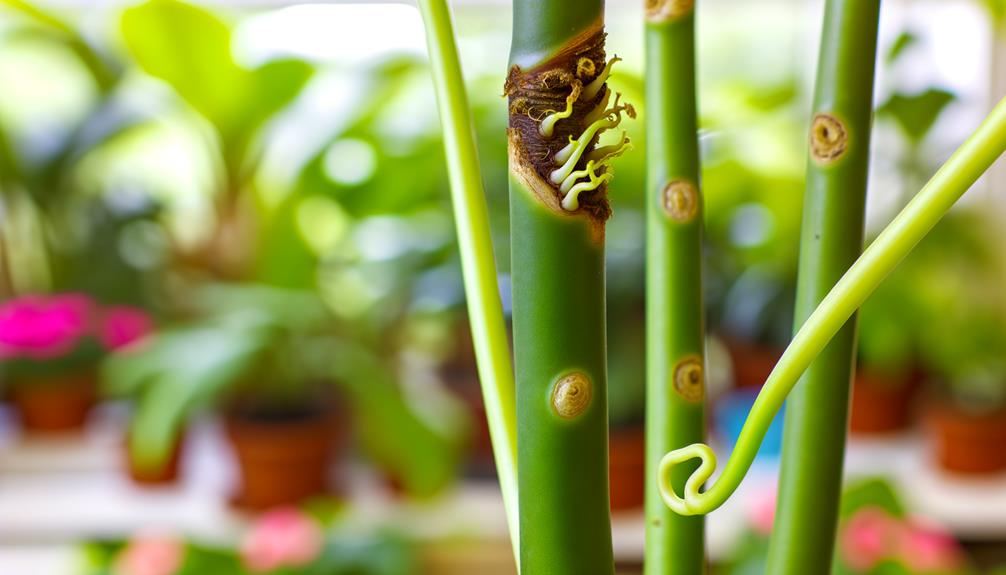
Node-based propagation is fundamentally reliant on the presence of nodes, which contain the necessary cellular structures for root development and subsequent plant growth.
In contrast, attempting propagation without nodes encounters significant biological challenges, as the absence of these critical structures impedes the formation of roots and shoots.
Understanding these differences is essential for optimizing propagation techniques and achieving successful outcomes in philodendron cultivation.
Importance of Nodes
Understanding the important role of nodes in philodendron propagation reveals why node-based methods generally outperform no-node approaches when it comes to successful root development and plant growth.
Nodes are critical for several reasons:
- Root Initiation: Nodes contain meristematic cells that can differentiate into root tissues, facilitating root development.
- Nutrient Transport: Nodes are crucial conduits for the transport of water, nutrients, and hormones, ensuring best growth.
- Growth Points: Nodes serve as the primary locations for the emergence of new shoots and leaves, contributing to the plant’s structural integrity.
These functional attributes underscore the necessity of nodes for effective philodendron propagation, making node-based methods notably more reliable than no-node alternatives.
Challenges Without Nodes
Propagation of philodendron without nodes frequently presents significant challenges due to the absence of critical meristematic cell clusters necessary for root and shoot development. Nodes contain these essential cells, which are indispensable for initiating new growth. Without nodes, the cuttings lack the inherent biological mechanisms required for successful propagation.
The following table compares the important differences between node and no-node propagation:
| Propagation Type | Presence of Meristematic Cells | Success Rate |
|---|---|---|
| With Node | Present | High |
| Without Node | Absent | Low |
| Node Importance | Vital | Significant |
Understanding these differences highlights why nodes are fundamental for effective propagation, ensuring that the plant can develop roots and shoots, thereby leading to healthy growth.
Success Stories With Nodes
Numerous gardeners have documented their successful experiences with node-based propagation of philodendrons, highlighting the pivotal role that nodes play in the development of new plants. Nodes are essential because they contain the necessary cellular structures for root and shoot formation.
Success stories frequently emphasize the following key factors:
- Optimal Conditions: Ensuring the right balance of humidity, light, and temperature is vital. Nodes exposed to high humidity and indirect light show rapid root development.
- Clean Cuts: Using sterilized tools to make precise cuts reduces the risk of infection and promotes healthy growth from the node.
- Water or Soil Mediums: Both water and soil mediums have shown efficacy, but using water allows for better monitoring of root development.
These practices underscore the importance of nodes in propagation.
Challenges Without Nodes

Attempting to propagate philodendrons without a node presents significant challenges due to the absence of essential cellular structures necessary for root and shoot development.
Nodes house meristematic cells, which are undifferentiated and capable of dividing to form roots and new growth. Without these critical cells, the plant lacks the biological foundation to initiate new growth.
Additionally, nodes are the primary sites for the distribution of plant hormones such as auxins and cytokinins, which regulate root and shoot formation.
The absence of nodes also impedes vascular connectivity, essential for nutrient and water transport. Consequently, cuttings without nodes generally fail to establish themselves as viable plants, resulting in a high rate of propagation failure.
Best Practices for Propagation
To successfully propagate philodendrons, it is crucial to use cuttings that include at least one node, ensuring the presence of essential meristematic cells and hormonal pathways for root and shoot development. Following best practices will greatly improve propagation success rates.
- Select Healthy Cuttings: Choose a stem section with at least one node and a few leaves to maximize photosynthesis during root formation.
- Proper Medium: Utilize a well-draining medium such as a mix of perlite and peat moss to maintain ideal moisture levels and prevent root rot.
- Environmental Conditions: Maintain high humidity and indirect light to support the delicate process of root establishment. Ideal temperatures range between 70-80°F (21-27°C).
These practices ensure a strong propagation environment conducive to healthy philodendron growth.
Conclusion
To sum up, the propagation of philodendrons without a node is highly unlikely due to the crucial role that nodes play in root and shoot development.
Nodes act as the main locations for growth and regeneration, making their absence a major obstacle to successful propagation.
As the saying goes, ‘You can’t make a silk purse out of a sow’s ear,’ emphasizing the importance of nodes in achieving viable philodendron propagation.
Implementing best practices guarantees higher success rates and robust plant development.


